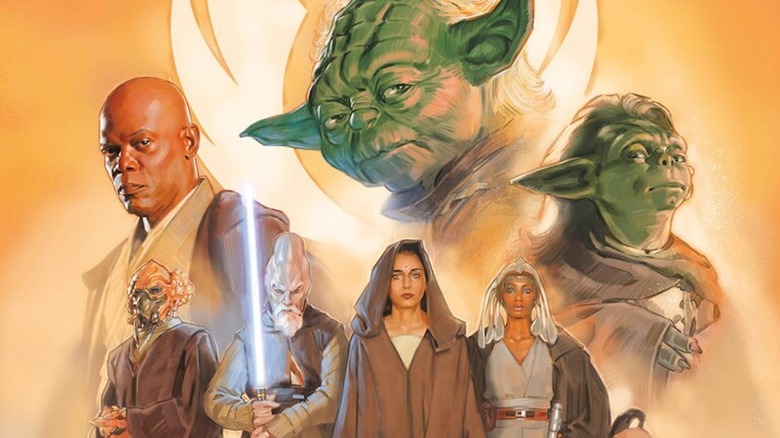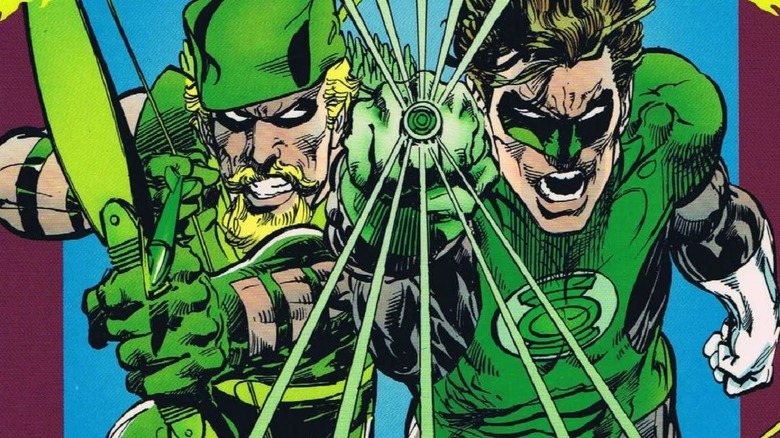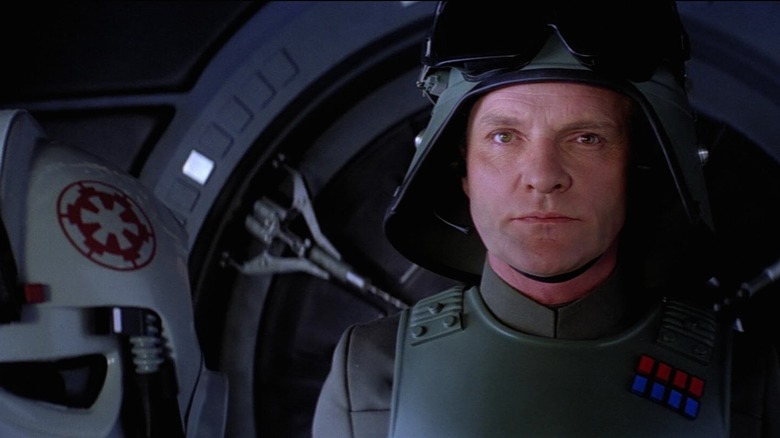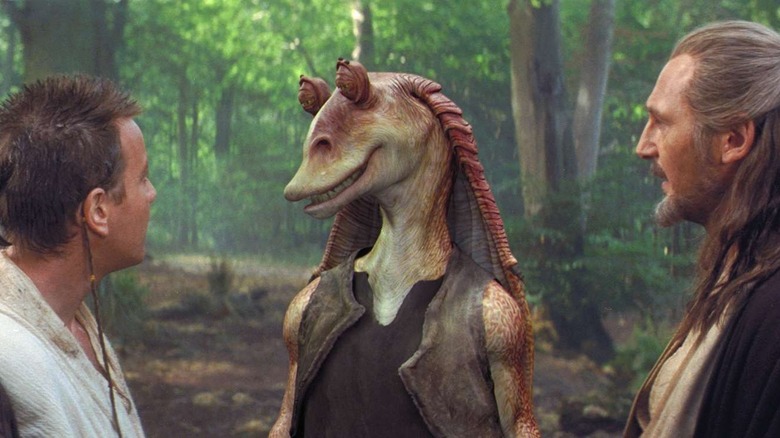A New Star Wars Novel Takes Readers On A Pre-Phantom Menace Road Trip Across The Galaxy
There will be minor spoilers for "Star Wars: The Living Force" by John Jackson Miller.
"Star Wars: The Living Force" is the latest novel released by Del Rey Worlds and Lucasfilm, carrying forward the legacy of the "Star Wars" universe. Set before the events of "Star Wars: The Phantom Menace," this novel sees Qui-Gon Jinn taking the council to task for the disarray in the universe. The Jedi are paying too much attention to the bigger picture of the Cosmic Force and ignoring the individuals in the galaxy and the whims of the Living Force.
As the Jedi are closing temples on far-flung worlds because the galaxy has only grown larger and their resources haven't expanded, Qui-Gon discovers that closing temples increases crime and reduces the quality of life in the systems where it's happening. He's able to challenge the Jedi Council to go on a space road trip to the planet Kwenn and see the results of their policies firsthand. He wants them to tap into the Living Force on their travels and get a better view of what the Force is actually trying to tell them.
Each member of the Jedi Council heads out on their own or in small groups, getting into their own misadventures along the way, giving them all a new appreciation of the place of the Jedi in the galaxy.
Hard Travelin' Heroes
John Jackson Miller has spent a lot of time in the world of comic books, so it came as no surprise to me that the book felt very much like a "Star Wars" version of the seminal 1970s team-up of Green Arrow and Green Lantern known as "Hard Travelin' Heroes," written by Denny O'Neil and drawn by Neal Adams. That story has Green Arrow challenge Green Lantern to a similar realization. Together, the pair road-trip across the United States to see what social evils there were, from racism to poverty and all points in between. It was an important moment in comic book history, to have these heroes reckon with the real-life, everyday politics of the people they aimed to serve. Translating that political commentary to "Star Wars" and sending the Jedi Council on a similar mission seems like a no-brainer of a concept.
Indeed, Miller is able to tailor the subject matter perfectly, both for the era of "Star Wars" and for modern audiences. There are issues of poverty and political corruption as well as corporate malfeasance and piracy. Overall, each member of the Jedi Council deals with their own piece of the problems in their own subplot, leaving each one a different understanding of what it was they were there to do and to learn. Because each Jedi is paired off, it gets back to that similar tone of the Green Arrow/Green Lantern comic book, with the two heroes bouncing dialogue against each other. It was an elegant solution to the narrative and a great inspiration.
Details to watch out for
The mind of John Jackson Miller is a steel trap and he has an innate sense of the "Star Wars" universe. Naturally, he's going to include more Easter eggs in his novel than you can shake a fist at, and do it with aplomb.
As far as highlights for things to watch out for, the biggest might be the inclusion of a very young General Veers. He appears as a very young member of a ship's crew with a good head on his shoulders. Much later in life, he would join the Empire and fight against the Rebellion. Here, he fights alongside the Jedi.
Jedi Master Sifo-Dyas is mentioned more than a few times as well, and we get a deeper window into this enigmatic character. Apparently, Sifo-Dyas was over-zealous in his recruiting efforts for the Jedi and was asked not to bring Younglings into the fold any longer. And by the time of the book, he's already left the Council but clashed with them about the need for an army.
Other flourishes obliquely reference other parts of "Star Wars." One particular moment has Jedi Master Yaddle offering a quote that is a bit of an inverse of Yoda's gem from "The Phantom Menace." "Fear is the path to the Dark Side," Yoda told Anakin. "Fear leads to anger. Anger leads to hate. Hate leads to suffering."
Yaddle, though, changes it up significantly, saying, "Courage leads to peace. Peace leads to love. Love leads to healing."
The last little Easter egg I'd like to point out is the inclusion of the Pod Chaser, an alcoholic beverage that originated aboard the Halcyon — the ill-fated Galactic Starcruiser. The Pod Chaser is basically just an Old Fashioned cocktail and I can tell you that, without question, it was the best Old Fashioned I've ever had. Delightful as it was, on the other hand, it's just one more disappointing reminder of the nonsensical closure of the Starcruiser.
The Living Force
At the end of the day, the tenets of the Living Force are something Qui-Gon holds dear and tries to teach the Jedi Council about. His entire philosophy can be summed up in his subplot. At the beginning of the book, Qui-Gon and his Padawan foil an attempt to rob a starship perpetrated by an incompetent crew of would-be criminals. Harmless as they are, Lobber, Wunga, and Ghor are more like the Three Stooges than they are actual criminals. Qui-Gon refuses to put them away or even kill them throughout the course of the novel. At the end, they're part of the key that helps Qui-Gon save the day, something that seems a little baffling to Obi-Wan.
But Qui-Gon explains to his apprentice, "The ways of the Living Force are mysterious. When you help one person now, you create the potential for them to do many good works in the future. Save a friend, Obi-Wan, and the friend may save you."
All of this is a brilliant preview of the situation with Jar Jar Binks in "The Phantom Menace," reinforcing the power of George Lucas's storytelling. A book like this is designed to bolster and highlight the ideas of the properties they're tying into. John Jackson Miller is able to enhance the dwindling days of the Jedi, offer a window into their hubris and how their decay led to Palpatine's grand plan. Palpatine himself is present, pulling the strings behind Chancellor Valorum's office, making this a must-read for more interesting context on "The Phantom Menace." It also serves as a welcome primer to all of the anonymous personalities we see on the Jedi Council. Miller did a terrific job characterizing all of them in their own way, creating a varied cast full of vibrant personalities.
It's a fun book that's inherently readable, offering a new window into Qui-Gon Jinn, which is always welcome.
Miller, who last wrote a "Star Wars" novel ten years ago with the "Star Wars Rebels" tie-in "A New Dawn," proves that he still has the chops to create compelling content in a galaxy far, far away. The book is fun, has an unexpected depth to it, and pays homage to some of my favorite things.
It was worth your time, especially if you love "The Phantom Menace" without reservation. If you're looking for another facet from which to enjoy "Episode I" or brook a greater understanding of the fall of the Jedi, then "The Living Force" is the book for you.
"Star Wars: The Living Force" is available wherever you buy books starting April 9, 2024.



